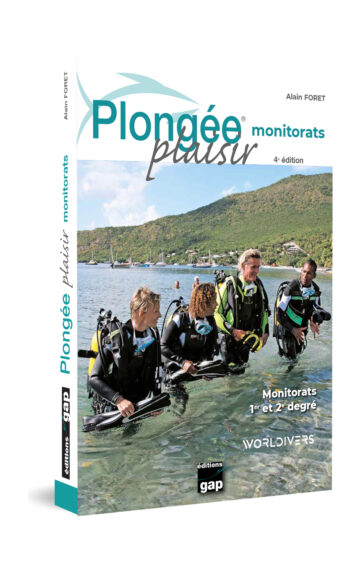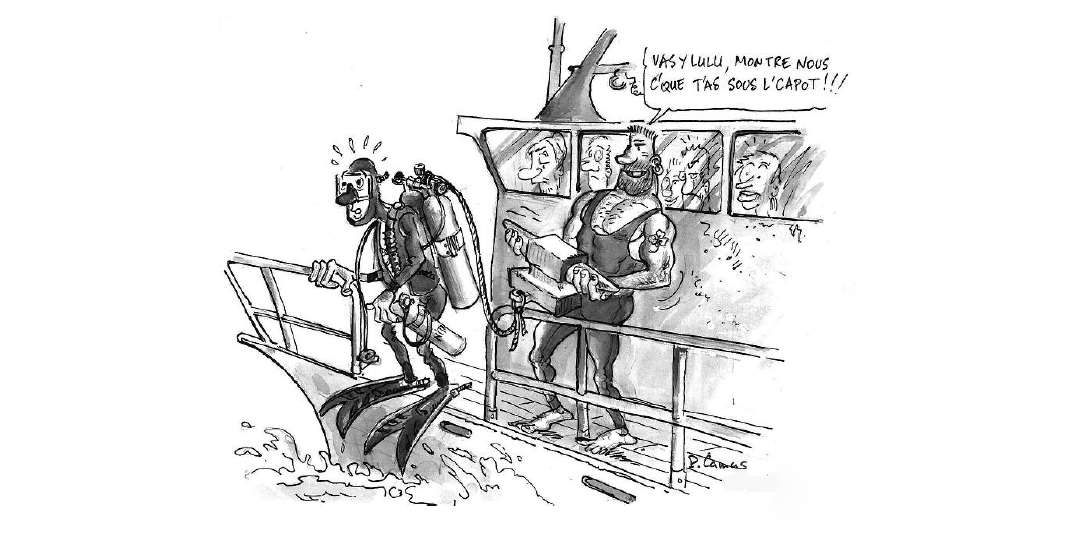
- Publisher: 448 p.
- Editor: GAP editions
- Editing: 4e édition, juin 2023
- Available in: Paper
- ISBN: 9782741707158
N ° 1 FOR DIVING TRAINING BOOKS![]()
4e édition de ce livre de référence pour votre formation aux monitorats fédéraux français (FFESSM et FSGT), d’Etat (BPJEPS, DEJEPS, DESJEPS) et internationaux (CMAS, FSSS, LIFRAS, PADI, NAUI, SSI …).
Presentation
Plongée Plaisir Monitorats est l’ouvrage indispensable à tout candidat au monitorat :
- MF1 et MF2 FFESSM ;
- MF1 et MF2 FSGT ;
- Monitorats CMAS ;
- BPJEPS, DEJEPS, DESJEPS (État).
Plongée Plaisir Monitorats s’adresse également aux tuteurs de stage et aux moniteurs en titre pour y puiser les éléments nécessaires à leurs cours.
Pour en faciliter l’accès, Plongée Plaisir Monitorats est organisé en 104 fiches pédagogiques regroupées en 4 parties :
1. Pédagogie générale (fiches n°1 à 26) ;
2. Enseigner la pratique :
- Gestes techniques à enseigner (fiches n°27 à 66) ;
- Bâtir un cours (fiches n°67 à 78) ;
3. Enseigner la théorie :
- Principaux thèmes à enseigner (fiches n°79 à 92) ;
- Réaliser un cours de théorie (fiches n°93 à 100) ;
4. Direction de plongée (fiches n°101 à 103).
La fiche n°104 est un mode d’emploi du livre à l’attention des tuteurs de stages et des candidats au monitorat 2e degré.
Plongée Plaisir Monitorats couvre ainsi tout le programme de formation.
Nouveautés de la 4e édition
- Précisions sur la notion d’évaluation (une seule méthode mais différents noms selon le moment, l’objet ou le type d’évaluation – initiale, formative, finale, continue, …).
- Refonte de la fiche sur le nettoyage, la désinfection et le rinçage du matériel.
- Refonte de la fiche sur la prévention des ADD.
- Refonte de la fiche sur l’enseignement de la désaturation (modélisation).
- Refonte de la fiche sur l’enseignement des procédures de désaturation.
- Refonte de la fiche sur la prévention du risque de narcose (différence entre “effets” et “crise”).
- Refonte de la fiche sur la transversalité.
- Refonte de la fiche sur les supports de cours.
- Retrait des éléments de réglementation, désormais disponibles dans le tome 4 de Plongée Plaisir (connaissances de fond).
- Rôle de directeur de plongée.
- Fiche de sécurité détaillée.
- Plan de secours détaillé.
- Procédure de secours détaillée.
View an excerpt to preview the book (pdf)
extraits-ppm-2023SUMMARY
Thanks
Photo credits
Mode d’emploi
1re partie : Pédagogie générale
Présentation
Étape n°1 : L’apprentissage
Fiche n°1 : Rendre les élèves actifs
Fiche n°2 : Limiter le nombre de consignes nouvelles
Fiche n°3 : Des briefings brefs et ordonnés
Fiche n°4 : La notion de justification
Fiche n°5 : Le poids des mots
Fiche n°6 : Conseils pour une communication réussie
Fiche n°7 : La notion de rétroaction (feedback) en pédagogie
Fiche n°8 : Les trois mémoires
Point d’étape n°1
Étape n°2 : Comment développer des compétences
Fiche n°9 : Notion de « prérogatives »
Fiche n°10 : Les trois savoirs
Fiche n°11 : La notion de « compétences »
Fiche n°12 : Développer des compétences par des situations-problèmes
Fiche n°13 : La notion de « transfert d’apprentissage »
Fiche n°14 : Logique « Prérogatives/Compétences »
Point d’étape n°2
Étape n°3 : Objectifs et progression pédagogique
Fiche n°15 : Pédagogie par les objectifs
Fiche n°16 : La notion de préalables (prérequis)
Fiche n°17 : La notion d’ « acquis »
Fiche n°18 : La notion de progression pédagogique
Point d’étape n°3
Étape n°4 : Les difficultés d’apprentissage
Fiche n°19 : Les sources de difficultés
Fiche n°20 : La notion de « stress »
Fiche n°21 : La notion de « remédiation » ou de « régulation »
Point d’étape n°4
Étape n°5 : Évaluation
Fiche n°22 : Les différentes formes d’évaluation
Fiche n°23 : Les critères d’évaluation
Fiche n°24 : Comment élaborer un sujet d’examen
Fiche n°25 : L’autoévaluation
Fiche n°26 : La notation
2e partie : Enseigner la pratique
Section I : Principaux gestes techniques à enseigner
Fiche n°27 : Gréer un scaphandre
Fiche n°28 : Dégréer un scaphandre
Fiche n°29 : Nettoyage, désinfection et rinçage du matériel
Fiche n°30 : Hiverner le matériel
Fiche n°31 : Les palmes
Fiche n°32 : Le palmage de sustentation
Fiche n°33 : Le palmage ventral
Fiche n°34 : Le palmage dorsal
Fiche n°35 : Un palmage respectueux
Fiche n°36 : Capelage et décapelage en surface
Fiche n°37 : Le masque
Fiche n°38 : La dissociation bucco-nasale (DBN)
Fiche n°39 : Le vidage de masque (VDM)
Fiche n°40 : Respirer avec de l’eau dans le masque
Fiche n°41 : Le tuba
Fiche n°42 : Passage embout/tuba
Fiche n°43 : Initiation à l’apnée
Fiche n°44 : Perfectionnement à l’apnée
Fiche n°45 : La combinaison et le lestage
Fiche n°46 : Les techniques de mise à l’eau
Fiche n°47 : Les techniques d’immersion
Fiche n°48 : Le lâcher-reprise d’embout (LRE)
Fiche n°49 : Prévention du risque de panne d’air
Fiche n°50 : Réaction à une panne d’air (plongeur encadré)
Fiche n°51 : Réaction à une panne d’air (plongeur autonome)
Fiche n°52 : Réaction à une panne d’air (encadrant de palanquée)
Fiche n°53 : Les signes de plongée
Fiche n°54 : Remontée sur expiration
Fiche n°55 : Le poumon-ballast
Fiche n°56 : Le gilet
Fiche n°57 : Le gilet : une bouée en surface
Fiche n°58 : Le gilet : une aide à la stabilisation
Fiche n°59 : La remontée d’un plongeur en difficulté
Fiche n°60 : Démonstration technique de remontée
Fiche n°61 : Évoluer en palanquée
Fiche n°62 : Guider une palanquée
Fiche n°63 : Utilisation d’un parachute de palier
Fiche n°64 : L’orientation en plongée
Fiche n°65 : Mannequin (niveau 4 et initiateur)
Fiche n°66 : Le baptême
Section II : Bâtir un cours
Fiche n°67 : « Commençons par la fin » ou « quel résultat faut-il obtenir » ?
Sheet no. 68: Differences between the practice framework and the examination framework
Sheet n°69: Phase 1 – reception
Sheet n°70: Phase 2 – presentation of the exercises
Sheet n°71: Demonstration of the monitor
Sheet n°72: Dry rehearsal by the pupils
Sheet n°73: Phase 3 – presentation of the session
Sheet n°74: Phase 4 – Reminder of safety rules and instructions
Sheet n°75: Phase 5 – carrying out the session in the water
Sheet n°76: Phase 6 – Debriefing
Sheet n°77: The different types of subjects
Fiche n°78 : Examinateurs et critères de notation
3e partie : Enseigner la théorie
Section I : Principaux thèmes à enseigner
Fiche n°79 : Pourquoi fait-on des cours de théorie en plongée ?
Fiche n°80 : Un préalable essentiel, la maîtrise du contenu
Fiche n°81 : Délimitation du cours : la logique prérogatives/compétences
Fiche n°82 : L’enseignement sur les oreilles en plongée
Fiche n°83 : L’enseignement de la prévention du risque de surpression pulmonaire
Fiche n°84 : L’enseignement des risques d’œdème pulmonaire d’immersion (OPI)
Fiche n°85 : L’enseignement de la prévention des risques d’accident de désaturation (ADD)
Fiche n°86 : L’enseignement de la désaturation : les modèles
Fiche n°87 : L’enseignement de la désaturation : les procédures
Fiche n°88 : L’enseignement de la prévention de l’essoufflement
Fiche n°89 : L’enseignement sur le froid en plongée
Fiche n°90 : L’enseignement de la prévention des risques de noyade
Fiche n°91 : L’enseignement de la prévention du risque de syncope hypoxique
Fiche n°92 : L’enseignement de la prévention du risque de narcose
Section II : Réaliser un cours
Fiche n°93 : « Commençons par la fin » ou «Quel résultat faut-il obtenir ? »
Fiche n°94 : Différences entre le cadre réel et le cadre de l’examen
Fiche n°95 : Faire un plan
Fiche n°96 : Transversalité
Fiche n°97 : Préparation du contenu du cours
Fiche n°98 : Les supports de cours
Fiche n°99 : Réaliser le cours
Fiche n°100 : Le cadre de l’examen
4e partie : Direction de plongée
Fiche n°101 : Le directeur de plongée (DP)
Fiche n°102 : L’organisation des plongées
Fiche n°103 : Procédure de secours
Fiche n°104 : Éléments de compréhension de la pédagogie au 2e degré
Index
Pleasure Diving Books
Books at Editions GAP
Printed on certified paper made from paper pulp from sustainably managed forests. The ink used is based on vegetable oil, the printing press adopts a progressive environmental approach validated by Imprim'vert certification.
A question, a suggestion, talk to the author, Alain FORET: Click here.

